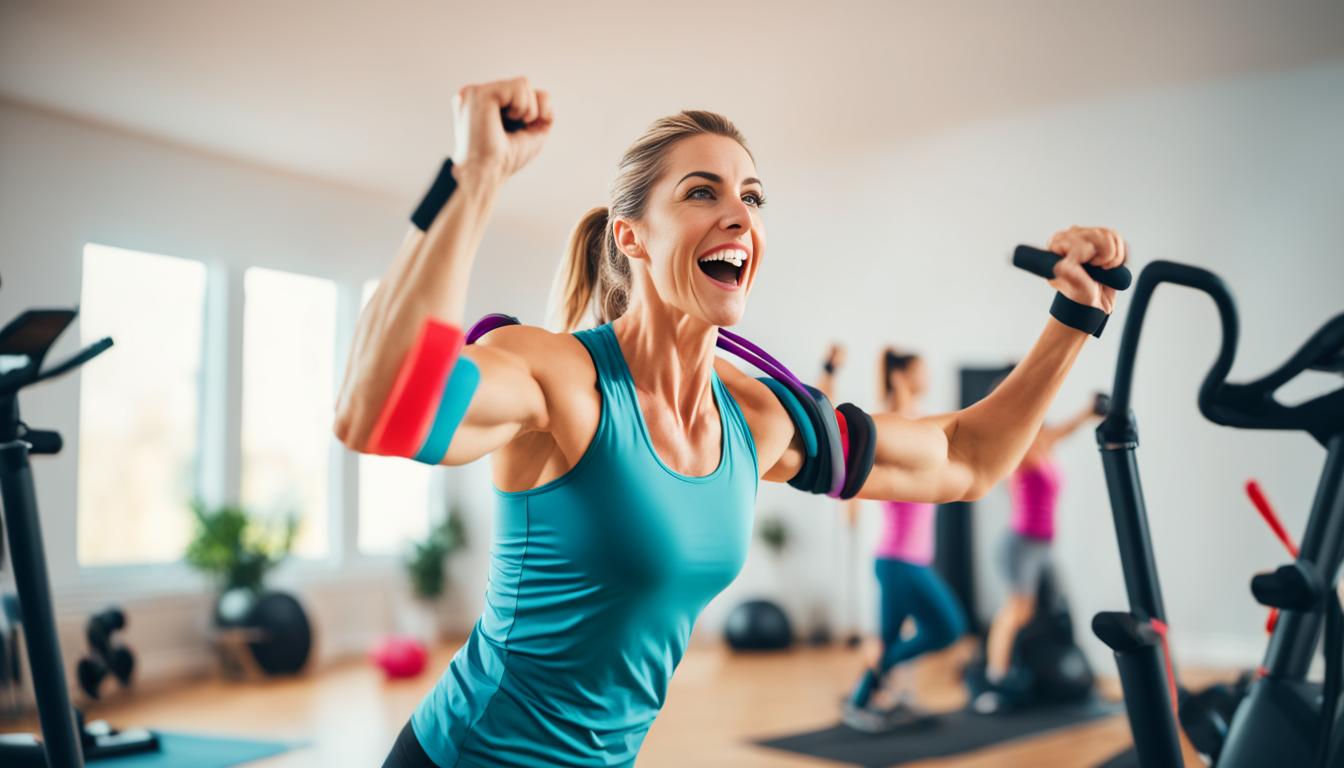Cardiovascular exercise, also known as cardio or aerobic exercise, is essential for good health. It gets your heart rate up, making your blood pump faster and delivering more oxygen throughout your body. Regular cardio exercise can help with weight loss, improve sleep, and reduce the risk of chronic disease. If you can’t get outside or go to the gym, there are plenty of cardio exercises you can do at home, from beginner moves like high knees and butt kicks to advanced moves like burpees and mountain climbers.
At-home cardio exercises are a convenient and effective way to maintain your fitness routine without leaving the comfort of your home. Whether you’re a beginner looking to kickstart your fitness journey or an advanced exerciser seeking new challenges, there’s a home cardio routine for you. Let’s explore the best cardio workouts for home and discover the benefits they offer.
Key Takeaways:
- Cardiovascular exercise is crucial for good health, and you can do it at home.
- There are various levels of cardio workouts for every fitness level.
- At-home cardio routines offer convenience and flexibility.
- Regular cardio exercise can aid in weight loss and reduce the risk of chronic disease.
- Explore the benefits of at-home cardio workouts and enjoy an energizing workout in the comfort of your own space.
Beginner Moves to Get You Started
If you’re new to cardio, these beginner cardio exercises are a great way to start your fitness journey right at home. No need for fancy equipment or a large workout space. Let’s dive into these beginner moves that will get your heart pumping and your body moving.
First up, we have high knees. Stand tall with your feet hip-width apart and start jogging in place, lifting your knees as high as possible. This exercise not only improves cardiovascular fitness but also helps to strengthen your leg muscles.
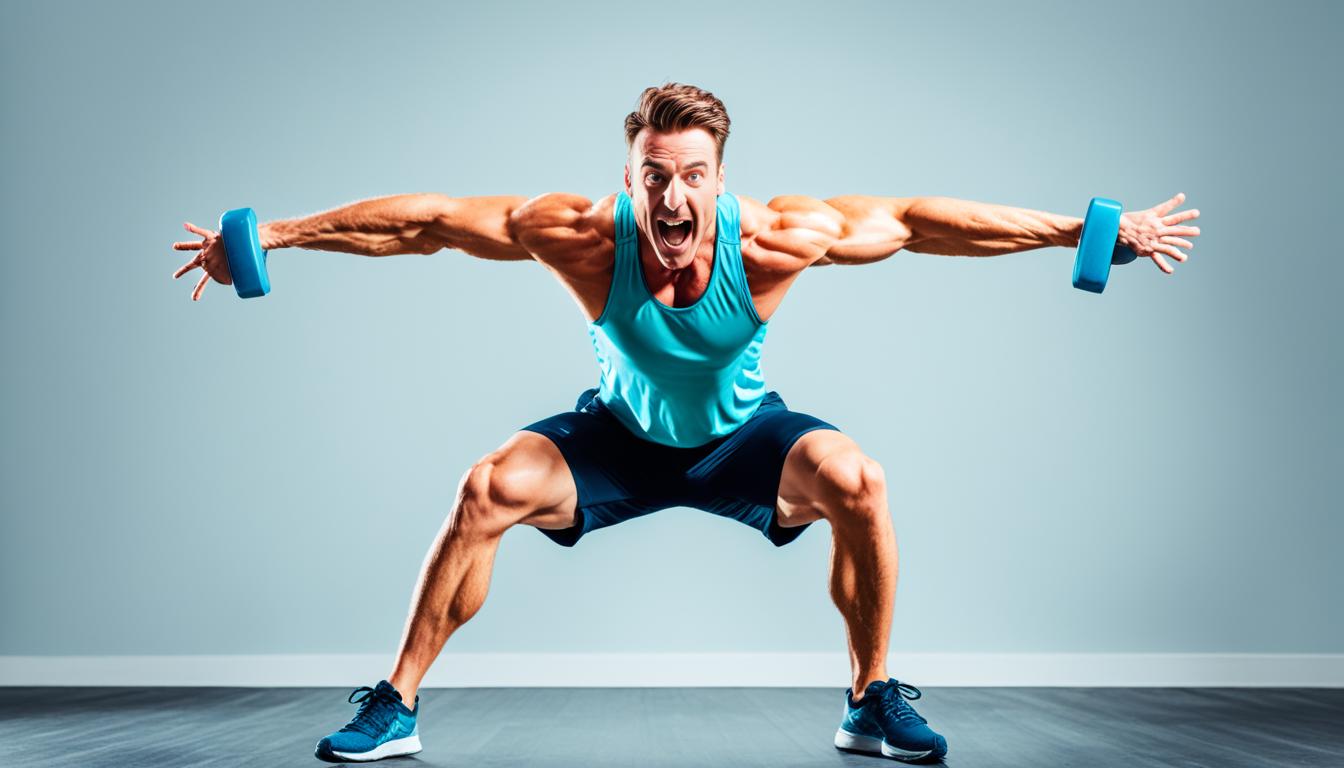
Next, let’s do some butt kicks. Similar to high knees, stand with your feet hip-width apart and start jogging in place. This time, focus on kicking your heels up towards your buttocks. Butt kicks are a great way to engage your hamstrings and improve your lower body strength.
If you have limited space, lateral shuffles are perfect for you. Stand with your feet shoulder-width apart and take a side step to the right, bringing your left foot next to your right. Repeat this movement, shuffling from side to side. This exercise helps improve your agility and works your leg muscles.
For a fun and engaging exercise, try the crab walk. Sit on the floor with your hands behind you, fingers pointing towards your feet. Lift your hips off the ground and begin walking backwards using your hands and feet. The crab walk targets your upper arms and core, helping to build strength in these areas.
Let’s not forget about your oblique muscles. Stand up straight and place your hands behind your head, elbows out wide. Next, perform a standing oblique crunch by bending to one side, bringing your elbow towards your hip. Return to the starting position and repeat on the other side. This exercise targets your oblique muscles and helps to strengthen your core.
Now, it’s time for some full-body movements. Get ready for speed skaters. Start by standing with your feet together. Jump to the right, landing on your right foot and swinging your left leg behind you, as if you’re ice skating. Repeat on the other side. Speed skaters not only get your heart rate up but also challenge your balance and coordination.
Another classic cardio exercise is jumping jacks. Begin by standing with your feet together and arms by your sides. Jump up, spreading your legs wide and raising your arms above your head. Jump again, bringing your feet together and lowering your arms to the starting position. Jumping jacks work your entire body and are a great way to boost your cardiovascular endurance.
Lastly, we have toe taps. Find a curb or step and stand in front of it. Lift one foot and tap the toe on the edge of the curb or step, then switch to the other foot. This low-impact exercise is great for beginners and focuses on building lower body strength and improving balance.
Now that you know these beginner moves, you’re ready to kickstart your cardio workout routine at home. Remember to start slowly and listen to your body. If you’re unsure about any exercises, it’s always a good idea to consult with a fitness professional or healthcare provider.
Intermediate Moves to Up the Intensity
Once you’ve built some endurance and strength, it’s time to take your cardio workout to the next level. These intermediate exercises will help you push your limits and challenge your body in new ways.
Squat Jumps
Add an explosive element to your regular squat with squat jumps. Start by standing with your feet shoulder-width apart, lower into a squat position, and then explode upwards, jumping as high as you can. Land softly back into the squat position and immediately repeat. This exercise engages your glutes, quadriceps, and calves, giving you a powerful lower body workout.
Standing Alternating Toe Touches
This exercise targets your arms, core, and legs. Begin by standing with your feet shoulder-width apart and arms extended out to the sides. Lift one leg and reach across with the opposite arm to touch your toes. Return to the starting position and repeat on the other side. This move not only challenges your stability and balance but also activates your abdominal muscles and improves flexibility.
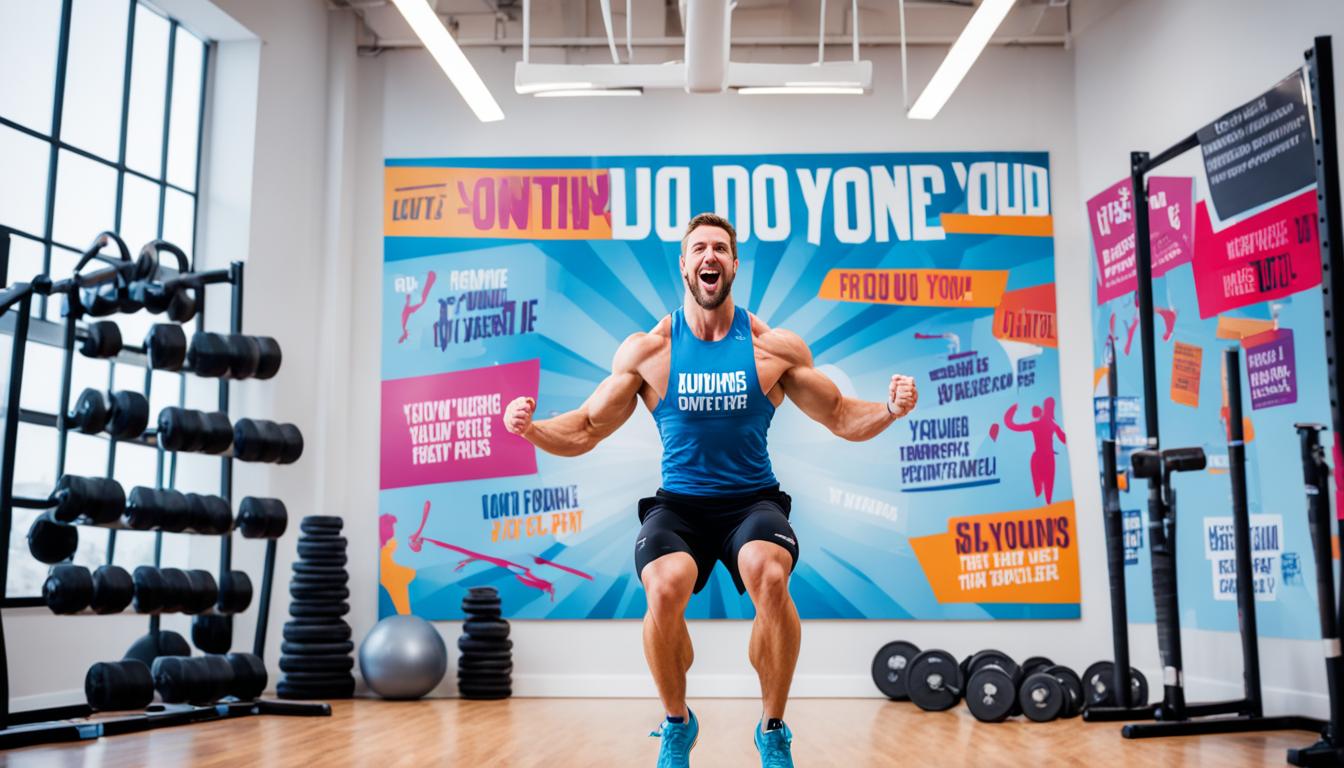
Lunge Jumps
Lunge jumps are a dynamic variation of lunges that elevate your heart rate and work multiple muscle groups simultaneously. Start by standing with your feet hip-width apart. Take a big step forward with your right foot and lower your body into a lunge position. From there, explode upwards, switching your legs mid-air and landing with your left foot forward. Repeat this movement, alternating legs with each jump.
Box Jumps
Box jumps are a challenging plyometric exercise that targets your lower body and improves power and explosiveness. Find a sturdy box or step that you can safely jump onto. Stand with your feet shoulder-width apart in front of the box. Bend your knees and swing your arms back, then propel yourself upwards, landing softly on the box with both feet. Stand up fully on the box before stepping back down and repeating the movement.
Plank Jacks
This challenging full-body exercise is a combination of the traditional plank and jumping jacks. Start in a high plank position with your hands directly under your shoulders and your body in a straight line. Jump your feet out to the sides and then back in, while maintaining a strong core and stable upper body. This exercise engages your core, shoulders, and legs, while also providing a cardiovascular challenge.
Advanced Moves to Keep Things Interesting
When you’re ready to take your cardio workout to the next level, it’s time to try some advanced exercises. These challenging moves will push your limits and keep you motivated. Whether you’re looking to improve your endurance, build strength, or simply add variety to your routine, these advanced cardio exercises are sure to deliver results.
Mountain Climbers
Mountain climbers are a fantastic full-body exercise that targets your core, arms, and legs. Start in a high plank position, with your hands directly under your shoulders and your body in a straight line. Engage your core and quickly alternate bringing one knee towards your chest while extending the other leg back. Keep up a fast pace, almost as if you’re climbing a mountain. This exercise will get your heart rate up and challenge your coordination.
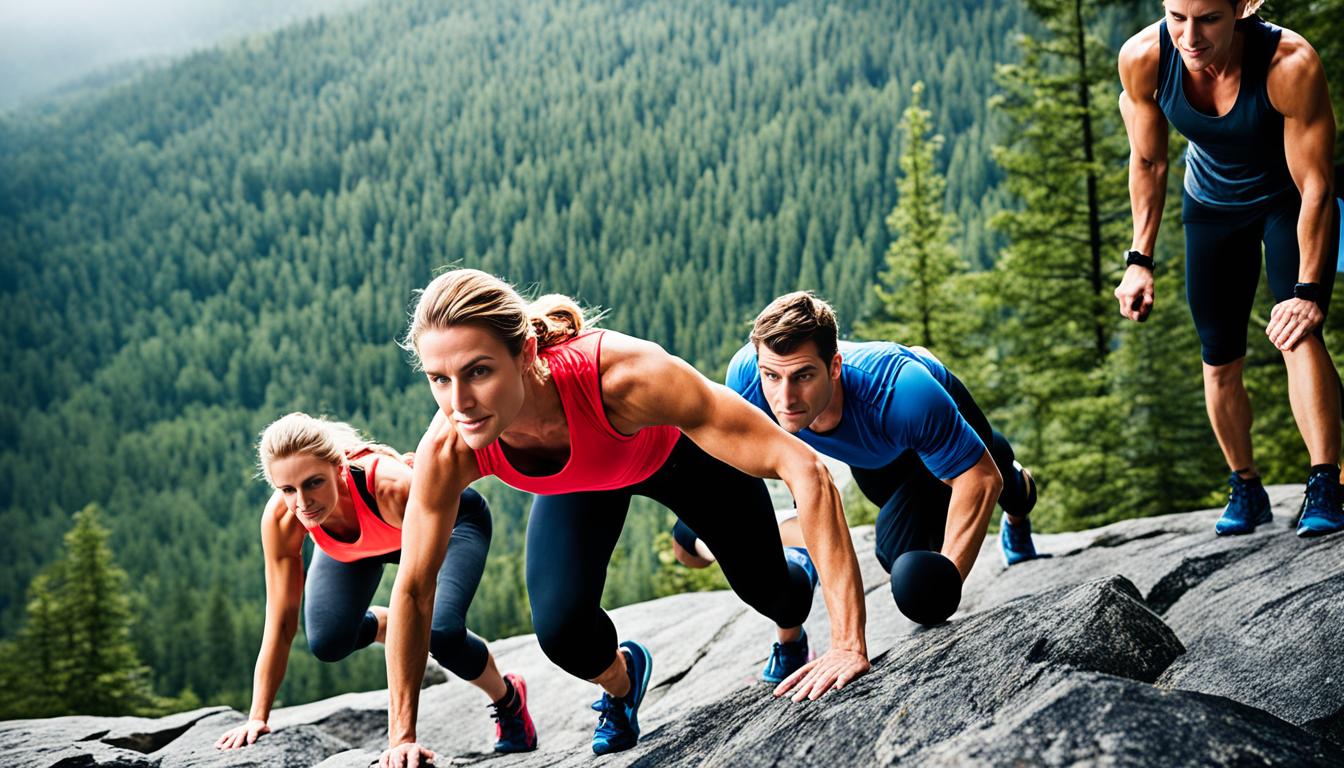
Plank Ski Hops
Plank ski hops are an intense exercise that combines the benefits of planks and cardio. Start in a high plank position and, while maintaining a strong core, jump both feet forward towards your hands and then quickly jump them back to the starting position. This exercise engages your abs, shoulders, and legs while also elevating your heart rate. Prepare to feel the burn!
Diagonal Jumps
Diagonal jumps are a dynamic exercise that targets your legs, glutes, and core. Start in a standing position with your feet shoulder-width apart. Jump diagonally to the right, landing on your right foot while the left foot crosses behind. Immediately jump diagonally to the left, landing on your left foot while the right foot crosses behind. Repeat this back-and-forth movement, maintaining a quick pace. Diagonal jumps are great for improving agility and cardiovascular endurance.
Rotational Jacks
Rotational jacks are a fun and challenging exercise that strengthens your legs, glutes, and core, while also improving your coordination. Start by standing with your feet together and your arms extended in front of you. Jump up, spreading your feet apart while rotating your body 180 degrees. As you land, jump back up and rotate back to the starting position. Keep repeating this rotational movement, trying to maintain a smooth, controlled motion throughout.
Burpees
Burpees are a classic and demanding exercise that targets your entire body. Start by standing with your feet shoulder-width apart. Squat down and place your hands on the floor in front of you. Kick your feet back into a plank position, perform a push-up, and then jump your feet back towards your hands. Explosively jump up, reaching your hands overhead. Repeat this sequence for the desired number of repetitions. Burpees are challenging but highly effective at elevating your heart rate and burning calories.
Inchworm Crawl
The inchworm crawl is a unique exercise that provides a full-body workout. Start by standing tall with your feet hip-width apart. Bend forward at the waist and place your hands on the floor. Walk your hands forward until you are in a high plank position, with your body in a straight line. From here, start walking your feet towards your hands, keeping your legs straight. Repeat this movement, inching your way forward. The inchworm crawl engages your arms, shoulders, core, and legs, making it a challenging cardio exercise.
Add these advanced cardio exercises to your routine to keep things interesting and continuously challenge your body. Remember to always listen to your body and perform these exercises with proper form to avoid injury. Enjoy the benefits of improved cardiovascular fitness and increased strength as you push yourself to new heights!
How to Get the Most Out of Your Workout
To maximize the benefits of your cardio workout, follow these tips:
Warm up: Start each session with a 5- to 10-minute warm-up to increase blood flow and relax your muscles. This can be as simple as a brisk walk or light jog to get your body ready for exercise.
Cool down: Gradually cool down during the last 5 to 10 minutes of your workout. This allows your heart rate to return to its normal pace and helps prevent dizziness or lightheadedness. Incorporate gentle stretches to improve flexibility and reduce muscle soreness.
Workout buddy: Exercising with a friend can make your cardio workout more enjoyable and motivate you to push harder. Find a workout buddy who shares your fitness goals and enjoys similar activities. You can encourage and push each other to achieve better results.
150 minutes of moderate activity: Aim to get at least 150 minutes of moderate activity each week. This can be spread out over five days by doing 30-minute sessions. Activities such as brisk walking, cycling, dancing, or swimming all count towards your weekly goal. Remember, consistency is key to achieving the desired cardiovascular benefits.
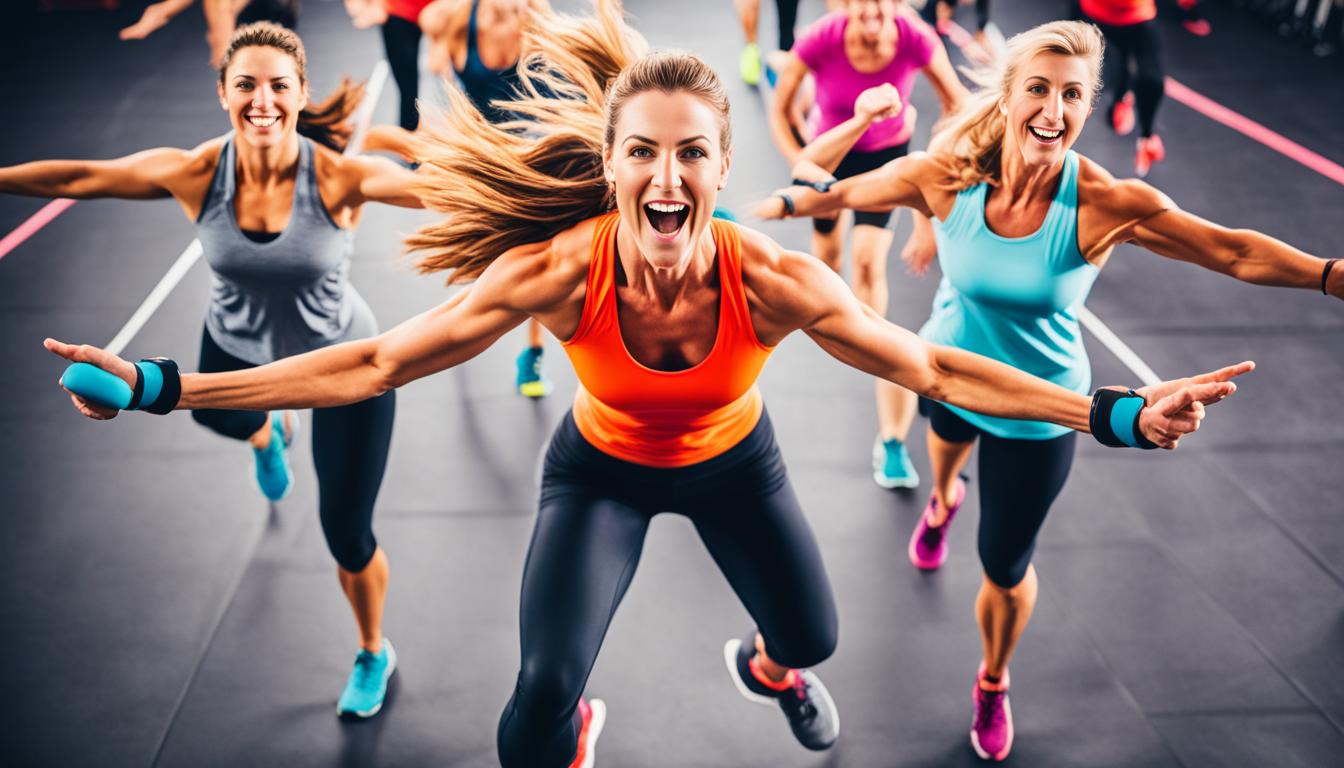
By following these cardio workout tips, including a proper warm-up, cool down, finding a workout buddy, and engaging in at least 150 minutes of moderate activity each week, you can maximize the effectiveness of your workouts and reap the numerous benefits of cardiovascular exercise.
Safety Considerations
If you’re new to exercise or have certain health conditions, it’s important to prioritize exercise safety and consult with your healthcare provider before starting a new program. Your healthcare provider is your best resource for personalized guidance based on your specific health status and fitness level.
If you have diabetes, hypertension, heart disease, arthritis, lung conditions, or past/current injuries, it is particularly crucial to have a healthcare provider’s input before embarking on a new exercise regimen. They can assess any potential risks and provide recommendations to ensure that you can exercise safely and effectively without exacerbating any existing conditions or causing harm.
By seeking a healthcare provider consultation, you can gain valuable insights and tailored advice that takes into account your unique circumstances. They can help you design an exercise plan that suits your needs, including appropriate modifications and precautions, if necessary. Remember, your provider’s expertise will ensure that you can engage in exercise activities that are both enjoyable and safe.
To make the most of your fitness journey, take the necessary steps to exercise responsibly by seeking professional medical guidance. Prioritizing safety will help you achieve your fitness goals without compromising your health.
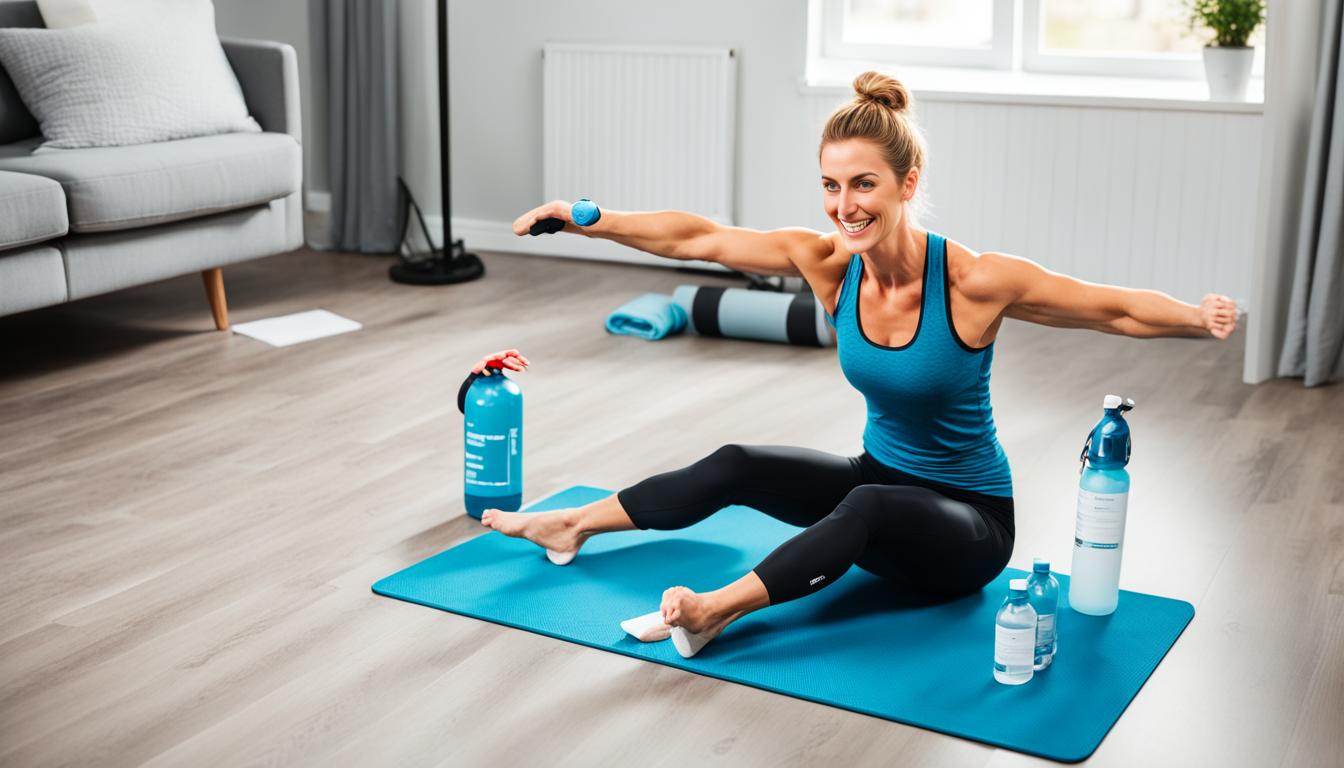
Safety First
“Before starting a new exercise program, it is essential to consult with your healthcare provider to ensure your safety and well-being.” – Dr. Emily Johnson, MD
Remember, your healthcare provider consultation is a crucial step in ensuring exercise safety, especially when starting something new. Don’t hesitate to reach out to your trusted medical professional before embarking on your fitness journey.
Benefits of Low-Impact Workouts
When it comes to exercise, low-impact workouts have their own unique benefits. Whether you’re a beginner, older adult, or someone getting back into fitness after a break, low-impact exercises can be a fantastic option for your fitness journey. Additionally, pregnant individuals, people with osteoarthritis, or low-back pain can also benefit from these types of workouts.
So, what exactly are low-impact exercises? They are activities that provide cardiovascular and strength-building benefits without putting excessive stress on the joints. Unlike high-impact exercises that involve jumping or running, low-impact workouts are gentler on the body while still offering numerous advantages.
One of the key benefits of low-impact workouts is their ability to increase endurance. By engaging in activities such as walking, swimming, or using an elliptical machine, you can gradually build up your stamina over time. This increased endurance will not only benefit your cardiovascular health but also help you in other aspects of your daily life.
Another advantage of low-impact exercises is their ability to build strength. While they may not have the same impact on your muscles as high-intensity workouts, they still engage various muscle groups and contribute to overall strength development. Strength-building exercises such as yoga, Pilates, or using resistance bands can offer a challenging workout without the strain on your joints.
Low-impact workouts also provide a gentle option for individuals with specific health conditions. If you have joint pain, arthritis, or are recovering from an injury, these exercises can be an excellent choice. They allow you to stay active and maintain your fitness levels without exacerbating any existing issues or causing further discomfort.
Low-impact workouts are a safe and effective way to improve cardiovascular health, build strength, and maintain fitness levels without putting excessive stress on your joints.
Image:
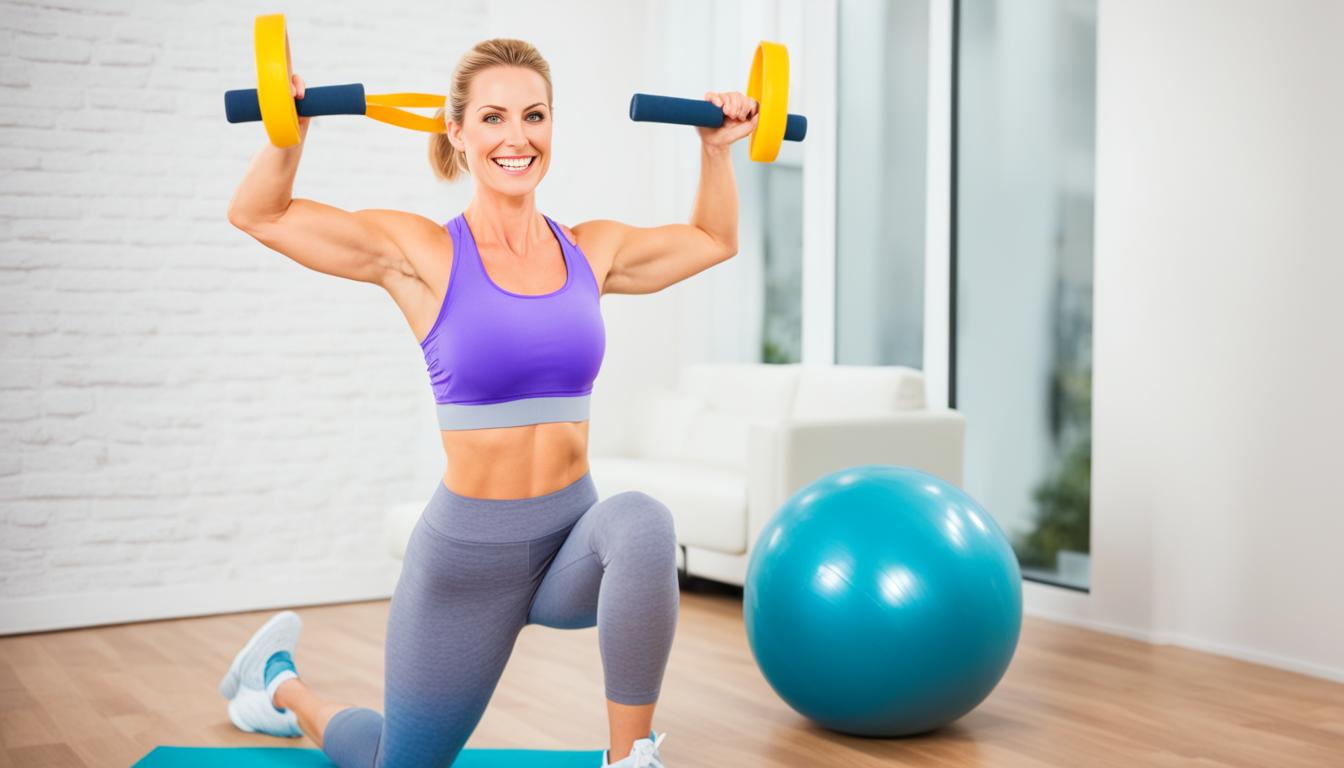
Illustration of a person performing low-impact exercises.
If you’re looking for a low-impact workout routine, there are plenty of options to choose from. Consider activities such as cycling, swimming, water aerobics, or using low-impact cardio machines. These exercises allow you to get your heart rate up and improve your overall fitness without the risk of joint pain or injuries.
Remember, before starting any exercise program, it’s always a good idea to consult with your healthcare provider, especially if you have any underlying health conditions. They can offer personalized advice and guidance to ensure that low-impact workouts are the right choice for you.
Incorporate low-impact exercises into your fitness routine and experience the benefits of gentle yet effective workouts.
Conclusion
Cardio workouts at home offer a multitude of benefits for your cardiovascular health and overall fitness. Whether you are a beginner or more advanced, there are home-based exercises that can suit your fitness level and help you achieve your goals. The convenience of working out at home provides flexibility and saves time, allowing you to fit exercise into your busy schedule.
The range of cardio workouts at home is vast, offering options for both high-intensity enthusiasts and those looking for low-impact exercises. You can choose from a variety of routines, including quick and intense workouts that get your heart rate up, or gentler options that focus on building endurance.
By incorporating home-based exercises into your daily routine, you can reap the benefits of regular cardio workouts. These include increased stamina, improved heart health, weight management, reduced stress levels, and enhanced overall well-being. With cardio workouts at home, you have the power to rev up your heart and energize your day, all within the comfort and privacy of your own space.
FAQ
What are some beginner moves to get started with at-home cardio workouts?
Some beginner moves you can try include high knees, butt kicks, lateral shuffles, crab walk, standing oblique crunch, speed skaters, jumping jacks, and toe taps.
What are some intermediate moves to up the intensity of my cardio workout?
To up the intensity, you can try squat jumps, standing alternating toe touches, lunge jumps, box jumps, and plank jacks.
What are some advanced moves for a more challenging cardio workout?
For a more challenging cardio workout, you can try mountain climbers, plank ski hops, diagonal jumps, rotational jacks, burpees, and inchworm crawl.
How can I get the most out of my cardio workout at home?
To get the most out of your cardio workout, remember to warm up and cool down, consider working out with a friend for added motivation, and aim for at least 150 minutes of moderate activity each week.
Are there any safety considerations when doing at-home cardio exercises?
It’s important to consult with your healthcare provider, especially if you have certain health conditions such as diabetes, hypertension, heart disease, arthritis, lung conditions, or past/current injuries. Your provider can offer guidance on exercising safely and effectively.
What are the benefits of low-impact workouts?
Low-impact workouts are a great option for beginners, older adults, and those returning to exercise after a break. They can also be beneficial for pregnant individuals, people with osteoarthritis, or low-back pain. Low-impact exercises provide cardiovascular and strength-building benefits without putting excessive stress on the joints.
What are the benefits of doing cardio workouts at home?
Cardio workouts at home are convenient and effective for improving cardiovascular health and overall fitness. They offer a range of exercises from beginner to advanced levels, allowing you to find routines that suit your fitness level and goals. Whether you prefer quick, high-intensity workouts or low-impact options, there are plenty of choices to keep you active and energized within the comfort of your own space.
Source Links
- https://www.self.com/story/8-low-impact-cardio-workouts
- https://www.cosmopolitan.com/health-fitness/advice/a34260/bedroom-cardio-workout/
- https://www.healthline.com/health/cardio-exercises-at-home

